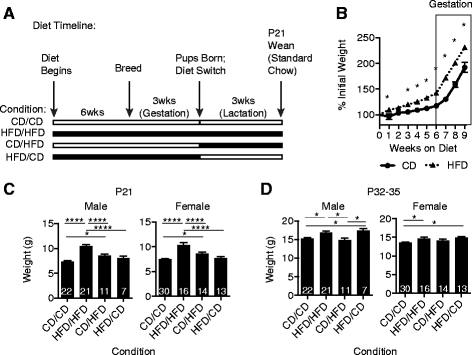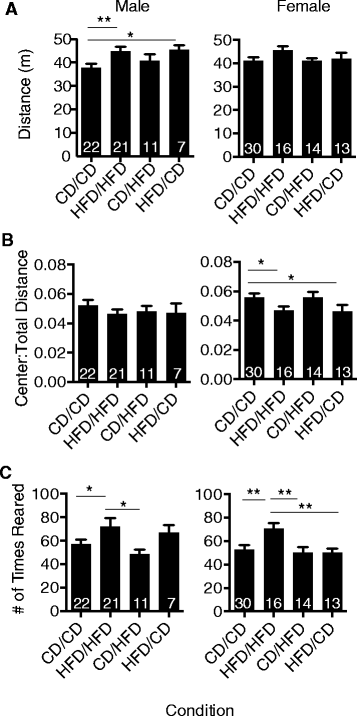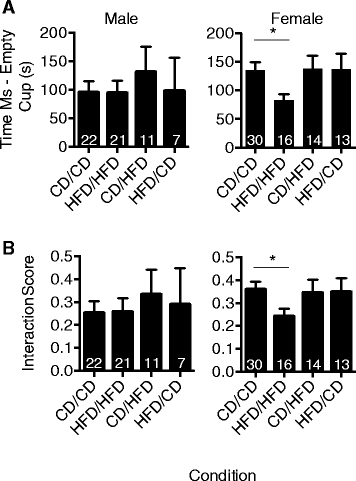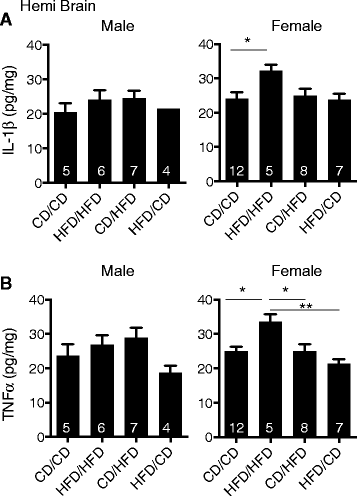Dietary intervention rescues maternal obesity induced behavior deficits and neuroinflammation in offspring
- PMID: 25212412
- PMCID: PMC4172780
- DOI: 10.1186/s12974-014-0156-9
Dietary intervention rescues maternal obesity induced behavior deficits and neuroinflammation in offspring
Abstract
Obesity induces a low-grade inflammatory state and has been associated with behavioral and cognitive alterations. Importantly, maternal environmental insults can adversely impact subsequent offspring behavior and have been linked with neurodevelopmental disorders such as autism spectrum disorder (ASD) and attention deficit hyperactivity disorder (AHDH). It is unknown if maternal obesity significantly alters offspring sociability, a key ASD feature, and if altering maternal diet will provide an efficacious intervention paradigm for behavioral deficits. Here we investigated the impact of maternal high fat diet (HFD) and maternal dietary intervention during lactation on offspring behavior and brain inflammation in mice. We found that maternal HFD increased anxiety and decreased sociability in female offspring. Additionally, female offspring from HFD-fed dams also exhibited increased brain IL-1β and TNFα and microglial activation. Importantly, maternal dietary intervention during lactation was sufficient to alleviate social deficits and brain inflammation. Maternal obesity during gestation alone was sufficient to increase hyperactivity in male offspring, a phenotype that was not ameliorated by dietary intervention. These data suggest that maternal HFD acts as a prenatal/perinatal insult that significantly impacts offspring behavior and inflammation and that dietary intervention during lactation may be an easily translatable, efficacious intervention to offset some of these manifestations.
Figures





Similar articles
-
Maternal obesity in the rat programs male offspring exploratory, learning and motivation behavior: prevention by dietary intervention pre-gestation or in gestation.Int J Dev Neurosci. 2012 Apr;30(2):75-81. doi: 10.1016/j.ijdevneu.2011.12.012. Epub 2012 Jan 5. Int J Dev Neurosci. 2012. PMID: 22239918
-
Maternal N-acetylcysteine supplementation in lactation ameliorates metabolic and cognitive deficits in adult offspring exposed to maternal obesity.Neuropharmacology. 2025 Jun 15;271:110390. doi: 10.1016/j.neuropharm.2025.110390. Epub 2025 Feb 27. Neuropharmacology. 2025. PMID: 40023441
-
Maternal high fat diet exposure is associated with increased hepcidin levels, decreased myelination, and neurobehavioral changes in male offspring.Brain Behav Immun. 2016 Nov;58:369-378. doi: 10.1016/j.bbi.2016.08.005. Epub 2016 Aug 9. Brain Behav Immun. 2016. PMID: 27519153 Free PMC article.
-
Maternal high-fat diet programming of the neuroendocrine system and behavior.Horm Behav. 2015 Nov;76:153-61. doi: 10.1016/j.yhbeh.2015.04.008. Epub 2015 Apr 24. Horm Behav. 2015. PMID: 25913366 Free PMC article. Review.
-
Maternal high fat diet consumption during the perinatal period programs offspring behavior.Physiol Behav. 2014 Jan 17;123:236-42. doi: 10.1016/j.physbeh.2012.07.014. Epub 2012 Oct 17. Physiol Behav. 2014. PMID: 23085399 Free PMC article. Review.
Cited by
-
Mapping trends and hotspot regarding gastrointestinal microbiome and neuroscience: A bibliometric analysis of global research (2002-2022).Front Neurosci. 2022 Nov 17;16:1048565. doi: 10.3389/fnins.2022.1048565. eCollection 2022. Front Neurosci. 2022. PMID: 36466165 Free PMC article.
-
Dietary fat: a potent microglial influencer.Trends Endocrinol Metab. 2022 Mar;33(3):196-205. doi: 10.1016/j.tem.2021.12.005. Epub 2022 Jan 22. Trends Endocrinol Metab. 2022. PMID: 35078706 Free PMC article. Review.
-
Gut microbiota and attention deficit hyperactivity disorder: new perspectives for a challenging condition.Eur Child Adolesc Psychiatry. 2017 Sep;26(9):1081-1092. doi: 10.1007/s00787-017-0969-z. Epub 2017 Mar 13. Eur Child Adolesc Psychiatry. 2017. PMID: 28289903 Review.
-
Maternal Pregravid Obesity Remodels the DNA Methylation Landscape of Cord Blood Monocytes Disrupting Their Inflammatory Program.J Immunol. 2017 Oct 15;199(8):2729-2744. doi: 10.4049/jimmunol.1700434. Epub 2017 Sep 8. J Immunol. 2017. PMID: 28887432 Free PMC article.
-
Offspring neuroimmune consequences of maternal malnutrition: Potential mechanism for behavioral impairments that underlie metabolic and neurodevelopmental disorders.Front Neuroendocrinol. 2017 Oct;47:109-122. doi: 10.1016/j.yfrne.2017.07.007. Epub 2017 Jul 20. Front Neuroendocrinol. 2017. PMID: 28736323 Free PMC article. Review.
References
-
- Levin BE, Govek E. Gestational obesity accentuates obesity in obesity-prone progeny. Am J Physiol. 1998;275:R1374–R1379. - PubMed
Publication types
MeSH terms
Grants and funding
LinkOut - more resources
Full Text Sources
Other Literature Sources
Medical

